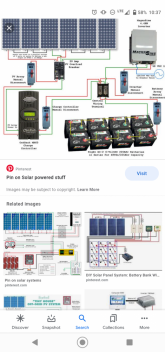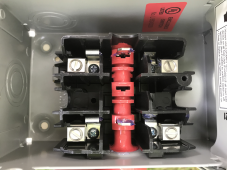I'm leaning towards a few of these so my wife or any visitors can easily see how to turn off the power. https://www.amazon.com/dp/B000MMC824/ref=cm_sw_r_cp_apa_fabc_6ZSH6ENZFQH6XBDAWNYV?psc=1
I like this style though, but it's $846
I have a combiner box, but if I'm running up to 100a controller to my batteries I want a legit easy to find emergency shut off switch at the batteries and maybe also at the combiner box 100ft away for our RV/camp setup where the panels are.
Midnight solar combiner with red switch:
For our future build this summer on our other cabin property with 50 panels I was thinking the midnight solar combiner box with built in switch on the front.
Current setup:
For the current RV combiner box it has a main breaker that feeds the batteries. I thought a big red switch or something below the combiner box and in the RV above the batteries in the battery compartment would be good/ safe/ and smart for my wife or someone who doesn't know my layout. Stickers warnings would be good too.
Disconnects I have seen:
An electrician installed a huge switch on my Dad's generator to turn off grid power, it was a lot bigger than the home depot 60amp 240v, but that was AC.
I've seen pull tabs, but that requires lifting the lid and then pulling it out and I'm not sure my wife or a friend would do that easily with adrenaline coursing through their veins. I need a big switch.
I have seen people use the blue seas battery switch like above, but I was thinking a large lever type. That's a lot of amps tlwith big arcs possible.
I didnt think I could use a home depot/Lowes AC switch with low volts high amps DC.
Thanks guys!
Another marine switch, 360a and for DC, but not quit just an on/off for emergencies.
I like this style though, but it's $846
I have a combiner box, but if I'm running up to 100a controller to my batteries I want a legit easy to find emergency shut off switch at the batteries and maybe also at the combiner box 100ft away for our RV/camp setup where the panels are.
Midnight solar combiner with red switch:
For our future build this summer on our other cabin property with 50 panels I was thinking the midnight solar combiner box with built in switch on the front.
Current setup:
For the current RV combiner box it has a main breaker that feeds the batteries. I thought a big red switch or something below the combiner box and in the RV above the batteries in the battery compartment would be good/ safe/ and smart for my wife or someone who doesn't know my layout. Stickers warnings would be good too.
Disconnects I have seen:
An electrician installed a huge switch on my Dad's generator to turn off grid power, it was a lot bigger than the home depot 60amp 240v, but that was AC.
I've seen pull tabs, but that requires lifting the lid and then pulling it out and I'm not sure my wife or a friend would do that easily with adrenaline coursing through their veins. I need a big switch.
I have seen people use the blue seas battery switch like above, but I was thinking a large lever type. That's a lot of amps tlwith big arcs possible.
I didnt think I could use a home depot/Lowes AC switch with low volts high amps DC.
Thanks guys!
Another marine switch, 360a and for DC, but not quit just an on/off for emergencies.
Last edited:








